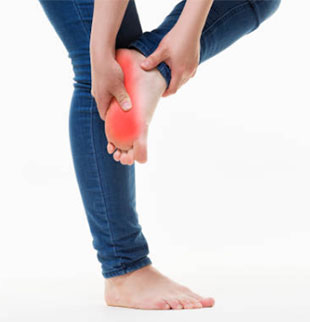Diabetic Foot Care Guidelines
 Diabetes can be dangerous to your feet—even a small cut could have serious consequences. Diabetes may cause nerve damage that takes away the feeling in your feet. Diabetes may also reduce blood flow to the feet, making it harder to heal an injury or resist infection. Because of these problems, you might not notice a pebble in your shoe—so you could develop a blister, then a sore, then a stubborn infection that might cause amputation of your foot or leg.
Diabetes can be dangerous to your feet—even a small cut could have serious consequences. Diabetes may cause nerve damage that takes away the feeling in your feet. Diabetes may also reduce blood flow to the feet, making it harder to heal an injury or resist infection. Because of these problems, you might not notice a pebble in your shoe—so you could develop a blister, then a sore, then a stubborn infection that might cause amputation of your foot or leg.
To avoid serious foot problems that could result in losing a toe, foot, or leg, be sure to follow these guidelines.
Inspect your feet daily. Check for cuts, blisters, redness, swelling, or nail problems. Use a magnifying hand mirror to look at the bottom of your feet. Call your doctor if you notice anything. (If your eyesight is poor, have someone else do it for you.)
Wash your feet in lukewarm (not hot!) water. Keep your feet clean by washing them daily. But only use lukewarm water—the temperature you’d use on a newborn baby.
Be gentle when bathing your feet. Wash them using a soft washcloth or sponge. Dry by blotting or patting—and make sure to carefully dry between the toes.
Moisturize your feet—but not between your toes. Use a moisturizer daily to keep dry skin from itching or cracking. But DON’T moisturize between the toes—this could encourage a fungal infection.
Cut nails carefully—and straight across. Also, file the edges. Don’t cut them too short, since this could lead to ingrown toenails.
Never trim corns or calluses. No “bathroom surgery”—let your doctor do the job.
Wear clean, dry socks. Change them daily.
Avoid the wrong type of socks. Avoid tight elastic bands (they reduce circulation). Don’t wear thick or bulky socks (they can fit poorly and irritate the skin).
Wear socks to bed. If your feet get cold at night, wear socks. NEVER use a heating pad or hot water bottle.
Shake out your shoes and inspect the inside before wearing. Remember, you may not feel a pebble—so always shake out your shoes before putting them on.
Keep your feet warm and dry. Don’t get your feet wet in snow or rain. Wear warm socks and shoes in winter.
Never walk barefoot. Not even at home! You could step on something and get a scratch or cut.
Take care of your diabetes. Keep your blood sugar levels under control.
Don’t smoke. Smoking restricts blood flow in your feet.
Get periodic foot exams. See your foot and ankle surgeon on a regular basis for an examination to help prevent the foot complications of diabetes.
Diabetic Shoes
Shoes for diabetic patients are made of special protective inserts and soft shoe materials to accommodate for conditions such as neuropathy (numb feet), poor circulation, and foot deformities (bunions, hammertoes, etc.). The shoes decrease the chance of foot sores (ulcers) which can be caused by friction and pressure. This may lead to infection, gangrene, or even amputation.
The foot and ankle surgeon may measure the diabetic patient’s foot and have the shoes made at a specialty laboratory. In some cases he/she will give the patient a prescription to have the shoes custom-made.
To find out more about diabetic shoes and foot care or other foot and ankle problems, please call us at 609-561-2488 or complete the consultation request form.
©2008 American College of Foot and Ankle Surgeons
The ACFAS presents this educational reference as a public service and for informational purposes only. The material is derived from the current medical knowledge on the topics listed. The content is not intended to be a substitute for professional medical advice, diagnosis, or treatment. Always seek the advice of your physician or other qualified health provider with any questions you may have regarding a medical condition. The opinions expressed do not necessarily represent the opinions of the ACFAS membership.
